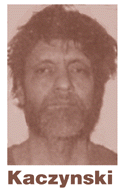 showing the bearded,
bristly-haired bombing suspect when first taken into FBI
custody.
showing the bearded,
bristly-haired bombing suspect when first taken into FBI
custody. Top of page
![]() "That's what we're investigating
now," said George Grotz, press relations agent for
the FBI's San Francisco office. He refused, however, to
give any details.
"That's what we're investigating
now," said George Grotz, press relations agent for
the FBI's San Francisco office. He refused, however, to
give any details.
![]() U.S. News reported in mid-April that
investigators were searching for recipts or other records
to show Kaczynski "used Trailways and Greyhound
buses to transport some of the bombs before mailing them
from different locations."
U.S. News reported in mid-April that
investigators were searching for recipts or other records
to show Kaczynski "used Trailways and Greyhound
buses to transport some of the bombs before mailing them
from different locations."
![]() In the 1980s, Salt Lake City, Utah was the
origin of several of the bomber's strikes. In the 1990s,
Sacramento and the Bay Area were sources from which four
bombs were mailed.
In the 1980s, Salt Lake City, Utah was the
origin of several of the bomber's strikes. In the 1990s,
Sacramento and the Bay Area were sources from which four
bombs were mailed.
![]() Sacramento was also the location of two of the
three Unabomb killings. On December 11, 1985, businessman
Hugh Scrutton was killed when a bomb exploded outside his
computer store, and on April 24, 1995, the president of
the California Forestry Association, Gilbert Murray, was
killed by a mail bomb in the associations Sacramento
headquarters.
Sacramento was also the location of two of the
three Unabomb killings. On December 11, 1985, businessman
Hugh Scrutton was killed when a bomb exploded outside his
computer store, and on April 24, 1995, the president of
the California Forestry Association, Gilbert Murray, was
killed by a mail bomb in the associations Sacramento
headquarters.
![]() At least 23 other individuals across the
country were wounded by Unabomber blasts. Altogether,
five bombings in Californa are attributed to the
Unabomber, so named by the FBI because of his early
university and airline targets.
At least 23 other individuals across the
country were wounded by Unabomber blasts. Altogether,
five bombings in Californa are attributed to the
Unabomber, so named by the FBI because of his early
university and airline targets.
![]() Appeals already being pursued by Kaczynski's
court-appointed defense counsel have given the FBI extra
time to continue its investigations, FBI spokesman Grotz
told Electric Nevada.
Appeals already being pursued by Kaczynski's
court-appointed defense counsel have given the FBI extra
time to continue its investigations, FBI spokesman Grotz
told Electric Nevada.
![]() "Under normal circumstances," said
Grotz, "under federal rules of criminal procedure,
the government has 30 days to take a case to court or to
file an indictment" after the initial filing of a
complaint.
"Under normal circumstances," said
Grotz, "under federal rules of criminal procedure,
the government has 30 days to take a case to court or to
file an indictment" after the initial filing of a
complaint.
![]() In this case, however, he said, the defense
attorney had filed a motion in federal court in Helena,
arguing that government leaks to the media had made it
impossible for his client to get a fair trial.
In this case, however, he said, the defense
attorney had filed a motion in federal court in Helena,
arguing that government leaks to the media had made it
impossible for his client to get a fair trial.
![]() "The district court judge there in Helena
denied the defense motion," he said, and then the
9th Circuit Court of Appeals in San Francisco denied it
again.
"The district court judge there in Helena
denied the defense motion," he said, and then the
9th Circuit Court of Appeals in San Francisco denied it
again.
![]() "At that point the defense appealed it
once again, to the Supreme Court," said Grotz,
adding that until the U.S. Supreme Court acts on the
appeal, the 30-day clock is stopped.
"At that point the defense appealed it
once again, to the Supreme Court," said Grotz,
adding that until the U.S. Supreme Court acts on the
appeal, the 30-day clock is stopped.
![]() "So on this initial charge, there is no
requirement that the government move at this point unless
and until the Supreme Court acts."
"So on this initial charge, there is no
requirement that the government move at this point unless
and until the Supreme Court acts."
![]() "Now, simultaneously, we're of course
putting our case together," said Grotz. "We're
investigating the case and perhaps the worst-kept secret
is, we will eventually move for indictment, and that can
come at any time."
"Now, simultaneously, we're of course
putting our case together," said Grotz. "We're
investigating the case and perhaps the worst-kept secret
is, we will eventually move for indictment, and that can
come at any time."
